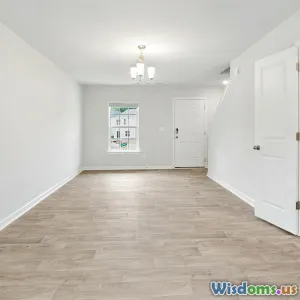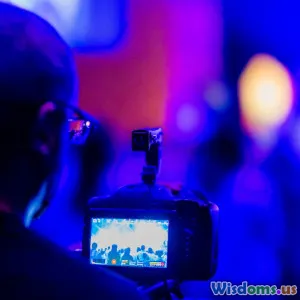
Can Smartphone Cameras Compete in Real Estate Photography
8 min read Exploring whether modern smartphone cameras can meet the demands of high-quality real estate photography. (0 Reviews)
Can Smartphone Cameras Compete in Real Estate Photography?
In an age where smartphones boast camera capabilities once found only in professional gear, it’s natural to wonder: can they genuinely stand up to dedicated cameras in real estate photography? High-quality property photos are crucial—they captivate buyers, emphasize space, and ultimately sell homes. This article ventures into the strengths and limits of smartphone cameras within this niche landscape, analyzing whether they’re a viable tool for realtors and photographers aiming for powerful property imagery.
Introduction: The Rising Power of Smartphone Cameras
Smartphones have transformed photography outside the studio. From stunning Instagram portraits to immaculate landscapes, phone cameras have won accolades and praise for remarkable advancements. Meanwhile, real estate photography demands images that showcase architectural details, lighting, and spatial warmth accurately, often hinting at lifestyle appeal beyond mere appearance.
Given these demands, can a smartphone capture the subtlety and precision a home needs to stand apart? Recent discoveries and trends signal that answering "yes" isn’t as far-fetched as before.
Understanding Real Estate Photography Needs
Before evaluating smartphones, it’s vital to understand what makes real estate photography successful.
Key Attributes
- Wide Field of View: Capturing all rooms and layouts authentically often requires wide-angle shots.
- High Resolution & Detail: Crisp images allow buyers to examine finishes, materials, and textures.
- Proper Lighting & Color Accuracy: Real estate thrives on natural and balanced light that flatters interiors.
- Minimal Distortion: Images should remain true to life without fácing odds created by drastic wide-angle lenses.
- Post-Processing Potential: Enhancements can polish images but must be authentic and subtle.
Professional photographers typically rely on DSLR or mirrorless cameras with specialized lenses to fulfill these criteria. The natural assumption is that smartphones lag behind, yet technology tells a more nuanced story.
The Technological Leap of Smartphone Cameras
Sensor & Lens Evolution
Top-tier smartphones like the iPhone 15 Pro Max, Google Pixel 8 Pro, and Samsung Galaxy S23 Ultra boast multi-lens arrays including ultra-wide, wide, and telephoto modules—addressing the field of view challenge expertly. Modern sensors capture larger light quantities, enhancing dynamic range and low-light performance.
Example:
The Samsung Galaxy S23 Ultra uses a 200-megapixel sensor per its Ultra camera, permitting stunning resolution and crop flexibility beyond conventional DSLRs for many real estate scenes.
Computational Photography
Arguably, the most game-changing aspect is computational photography—the software-driven interpretation of raw images. Technologies like HDR, AI-based color correction, and night mode drastically improve photos after capture.
Google Pixel, particularly, has earned fame for its Night Sight mode, overcoming dim interiors without bulky light setups. Apple’s Deep Fusion adds texture and clarity in shadows and mid-tints.
Portability and Accessibility
A smartphone is always in your pocket, facilitating spontaneous shoots. Real estate agents juggling multiple listings can update listings swiftly without elaborate gear.
Comparative Analysis: Smartphones vs Professional Cameras in Real Estate
Image Quality
- Resolution: High-end phones now surpass entry-level DSLRs in megapixels but typically have smaller sensor sizes, impacting noise and depth.
- Dynamic Range: DSLRs retain superior dynamic range, preserving details in extreme shadows/highlights.
- Lens Quality: Dedicated glass outperforms micro lenses on phones, especially controlling distortion and depth.
However, smartphones increasingly close the gap thanks to advanced post-processing.
Flexibility and Features
DSLRs offer interchangeable lenses—a must for interior, exterior, and detail shots. Phones rely on built-in lenses but compensate via software.
Ease of Use and Cost
Smartphones enable painless usage without technical setup. For agents without photography skills or gear budgets, they’re attractive.
Professional cameras demand investment, learning, and potentially extra lighting equipment but yield consistent quality.
Real-World Examples
Case Study: Real Estate Agent Turnaround
Jessica Turner, a San Diego real estate agent, transitioned from DSLR to smartphone (iPhone 14 Pro) photography for her listings during the COVID period. Initially skeptical, she reported:
"The iPhone’s ultra-wide lens and night mode helped me capture bright, spacious feeling interiors even in shaded homes. Buyers responded positively, and I saved thousands on photography costs."
Her listing views rose by 20% after using smartphone images paired with minor edits via Snapseed.
Photographer Perspective
Veteran photographer David Liu integrated the Google Pixel 7 Pro as a quick option for urgent shoots, praising its processing but maintaining DSLR superiority for marketing luxury estates where every pixel matters.
Smart Tips For Leveraging Smartphone Cameras
- Use External Lenses: Clip-on wide-angle lenses augment field of view limitations.
- Master Lighting: Utilize natural light positioning, orange-hour timings for warmth.
- Stabilize Your Shot: Harness tripods or gimbals with smartphone mounts to avoid blur.
- Edit Thoughtfully: Employ apps like Lightroom Mobile to enhance, not distort.
- Shoot in RAW: Some phones support RAW capture improving post-process latitude.
Limitations and Challenges
Even with virtues, smartphone cameras face hurdles:
- Physical Sensor Constraints: Still inferior in very low light or extreme conditions.
- Lens Distortion: Ultra-wide lenses can bend walls unpredictably.
- Depth Perception: Achieving natural bokeh or separation is trickier.
- Battery and Storage: Extensive shooting impacts operational longevity.
Conclusion: The Verdict on Smartphones Competing in Real Estate Photography
Smartphone cameras have surged forward, offering a surprisingly robust alternative for real estate imagery especially in budget-conscious or rapid-turnaround scenarios. Their convenience, computational prowess, and improving optics empower agents and casual photographers alike to produce appealing photos with minimal overhead.
Nonetheless, for high-end luxury properties or when exacting detail and perfection are non-negotiable, professional cameras remain premier. The ideal choice depends on the property type, marketing goals, and user expertise.
Real estate professionals should embrace a hybrid mindset—leveraging smartphones for accessibility and immediacy, complemented by DSLR or mirrorless systems when image quality can sway high-stakes sales.
The evolution of smartphone photography signals an exciting democratization of property marketing visuals, blurring the lines and expanding creative horizons.
Authors Note: Continued innovation may further close this gap; staying abreast of device updates is crucial for those merging technology with real estate sales.
Rate the Post
User Reviews
Popular Posts


















